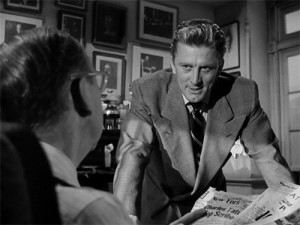STUDIO: Criterion | DIRECTOR: Billy Wilder | STARS: Kirk Douglas, Jan Sterling, Robert Arthur, Porter Hall, Frank Cady
RELEASE DATE: 5/6/14 | PRICE: Blu-ray/DVD Combo $39.95
BONUSES: audio commentary by Neil Sinyard, French documentary on Billy Wilder, Wilder Q&A at the American Film Institute, audio interview with coscripter Walter Newman, 1984 interview with Kirk Douglas, afterword by Spike Lee, essays by Molly Haskell and Guy Maddin
SPECS: NR | 111 min. | Drama | 1.37:1 fullscreen | Monaural
Upon its release, the dark, brilliant noir Ace in the Hole was a box office flop. In the years since, it has rightfully been lauded as an uncommonly prescient statement about the exploitation of a tragedy by the media. This release is a dual-format re-release of the 2007 Criterion edition of Ace, containing three discs (two DVD, one Blu-ray).
The plot is uncommonly nasty, even for a noir drama: looking for the big story that will get him back to a big city and out of Albuquerque, N.M., enterprising newsman Chuck Tatum (Kirk Douglas, Paths of Glory) latches on to the tale of a man caught inside a mountain by a cave-in. Tatum guarantees himself exclusive access to the story by making shady deals with the local sheriff and the victim’s wife. He goes so far as to persuade the engineers working to get the man out to use an alternate method of excavation that will guarantee the tragedy lasts longer.
Filmmaker Billy Wilder (Sabrina) never shied away from having a heel as his protagonist, and Kirk Douglas’s Tatum is a consummate sleaze (until the third act, in which he does feel pangs of conscience). The notion of a newsman manipulating events wasn’t a new one, but Wilder and his co-scripters did it to a fine turn here, letting us know that Tatum’s business deals are literally killing a man.
The critique of the American “entrepreneurial spirit” is spelled out beautifully in the scenes when a carnival, replete with a Ferris wheel, is built up around the site of the cave-in (thus the film’s alternate/TV title, The Big Carnival).
Having jump-started the noir cycle with Double Indemnity and brilliantly mocked one of its main tenets (jaded voiceover narration) in Sunset Boulevard, here Wilder contributes one of the darkest visions of America in Fifties cinema (“noir in broad daylight,” as it is referred to by critic Molly Haskell in an essay included here).
And what is a noir without a hard-boiled dame? Jan Sterling fits that function perfectly, adding a snotty sarcasm to one of Wilder’s best lines, a tart response to Tatum’s demand that she go to a mass for her husband: “I don’t go to church. Kneeling bags my nylons.”
The supplements in this set shed a great deal of light on the production, Wilder’s working methods and his blissfully cynical attitude towards the movie business. Seen in a 1984 interview, Kirk Douglas speaks with nothing but admiration of working with Wilder. Spike Lee (Oldboy) offers an “afterword,” citing its realistic view of the “dangerous” side of the medium and compares it to the equally prescient Face in the Crowd.
Wilder is heard from in a 1986 Q&A at the American Film Institute, where he addresses the three-act structure of his screenplays and discusses his avoidance of “fancy-schmancey” shots in his work.
The most information-filled supplement is a French video documentary in which Positif editor Michel Ciment interviews Wilder in the early Eighties. Wilder talks about a broad array of topics, and his frequent stars Jack Lemmon and Walter Matthau also tell their favorite Wilder anecdotes.
The filmmaker offers his memories of Vienna and Berlin between the wars, as well as his off-the-cuff opinions about colleagues like Marlene Dietrich (“a German hausfrau” who preferred housekeeping to glamour when offscreen). Wilder also offers the secrets of Alexander Trauner’s sublime production design for his films — as in The Apartment when the immensity of Lemmon’s office was achieved via matte paintings and little people in the distance, sitting at miniature desks.
Instead of a booklet, the set comes with a small mock newspaper containing essays by critic Molly Haskell and filmmaker/enthusiastic movie buff Guy Maddin (Careful). Haskell marvels that with “two main characters so monstrous in their mutual, and mutually despising, selfishness that it’s astonishing the movie got released at all.”
Maddin, in his turn, rhapsodizes about the film’s star: “With Kirk Douglas, whose body has always seemed made up of a series of triangles, whose face is a sizzling griddle cake of unconcealed emotion, and whose voice is a rising staccato spiral of agony, you always know what you’re going to get, but it’s always far better than you anticipate.”
|
Buy or Rent Ace in the Hole
|
|||
|---|---|---|---|
Blu-ray/DVD Combo |
 Blu-ray/DVD Combo Blu-ray/DVD Combo |
 Blu-ray/DVD Combo Blu-ray/DVD Combo |
|

Leave a Reply